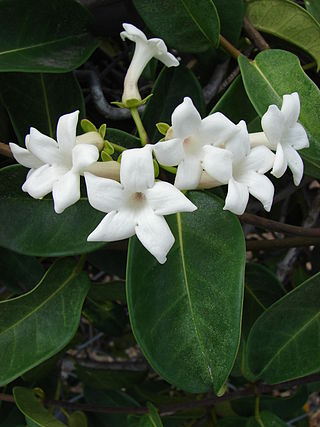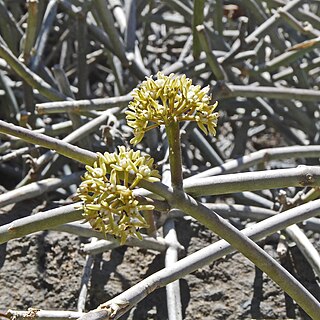
The Asclepiadoideae are a subfamily of plants in the family Apocynaceae. Formerly, they were treated as a separate family under the name Asclepiadaceae, e.g. by APG II, and known as the milkweed family.

Stapeliinae is a subtribe of flowering plants within the subfamily Asclepiadoideae of the family Apocynaceae. The subtribe comprises about 35 genera, including both the stem-succulent "stapeliads" and the horticulturally popular genera Brachystelma and Ceropegia. The largest number of genera are native to Africa, but a more limited number of genera are widespread in Arabia and Asia.

Cynanchum is a genus of about 300 species including some swallowworts, belonging to the family Apocynaceae. The taxon name comes from Greek kynos and anchein, hence the common name for several species is dog-strangling vine. Most species are non-succulent climbers or twiners. There is some evidence of toxicity.

Stephanotis is a genus of flowering plants first described in 1806. The name derives from the Greek stephanōtís fit for a crown, derivative of stéphanos (masculine) crown. It contains evergreen, woody-stemmed lianas with a scattered distribution in several tropical and subtropical regions.

Marsdenia is a genus of plants in the family Apocynaceae first described as a genus in 1810. It is named in honor of the plant collector and Secretary of the Admiralty, William Marsden. The plants are native to tropical regions in Asia, Africa, Australia, and the Americas.

Cynanchum socotranum, synonym Sarcostemma socotranum, is a species of plant in the family Apocynaceae. It is endemic to Socotra Island, south of Yemen. Its natural habitat is subtropical or tropical dry shrubland.

Vincetoxicum is a genus of plants in the family Apocynaceae. Although the species in Vincetoxicum have sometimes been included in Cynanchum, chemical and molecular evidence shows that Vincetoxicum is more closely related to Tylophora, now included in Vincetoxicum. The generic name means "poison-beater" in Botanical Latin because of the plants' supposed antidotal effects against snakebite.
Dischidanthus is a genus of plants in the family Apocynaceae, first described as a genus in 1936. Species of the genus are native from the east Himalayas to south China and Peninsular Malaysia. It may be treated by some sources as a synonym of Marsdenia.
Tassadia is a genus of plants in the family Apocynaceae, first described as a genus in 1844. It is native primarily to South America, with one species extending north into Central America, S Mexico, and Trinidad.

Cynanchum daltonii, synonym Sarcostemma daltonii, is a species of flowering plants of the family Apocynaceae. The species is endemic to Cape Verde. The specific name refers to Joseph Dalton Hooker. The species was named by Joseph Decaisne, as Sarcostemma daltonii, in 1849. Its local name is gestiba. The plant is used in traditional medicine to relieve and treat dental problems.
Leichhardtia mackeeorum, synonym Marsdenia mackeeorum, is a species of vine in the family Apocynaceae. It is endemic to New Caledonia.
Vincetoxicum lineare is a species of plant in the family Apocynaceae native to Australia. Known as the bush bean, it is an edible species of plant found in arid regions. As Rhyncharrhena linearis, the species was at one time the only species in the monotypic genus Rhyncharrhena.
Desmidorchis is a genus of flowering plants belonging to the family Apocynaceae.
Vincetoxicum forsteri is a species of plant in the dogbane family Apocynaceaethat is endemic to Australia. It was first described by Paul Irwin Forster in 1992 as Tylophora linearis.

Ruehssia is a genus of plants in the family Apocynaceae. It is also in the Asclepiadoideae subfamily and Marsdenieae tribe.
Vincetoxicum cameroonicum is a species of flowering plant in the family Apocynaceae, native from Benin to Uganda in tropical Africa. It was first described by N. E. Brown in 1895 as Tylophora cameroonica.
Vincetoxicum anomalum is a species of flowering plant in the family Apocynaceae, native to the island of Bioko and Cameroon in the west of Africa, and from Uganda to KwaZulu-Natal and the island of Mayotte in the east of Africa. It was first described by N. E. Brown in 1908 as Tylophora anomala.
Gongronemopsis is a genus of flowering plants in the dogbane family, Apocynaceae. It includes nine species native to tropical Africa and Madagascar, the Indian subcontinent, Indochina, southern China, and the Philippines.








